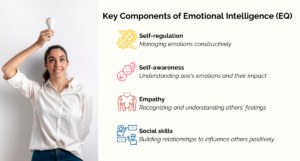
“The Devil Wears Prada” vs. “Mother Teresa”: Balancing Emotional Leadership
“The Devil Wears Prada” vs. “Mother Teresa”: Balancing Emotional Leadership https://tcpgrowth.com/wp-content/uploads/2024/10/Oct2024_Cover_Option2-1024x550.png 1024 550 Ray Yuen Ray Yuen https://secure.gravatar.com/avatar/ca877dadc931d1f0186313170e8aa1557197a2b620fabfb04e4dc7adc1023789?s=96&d=mm&r=g- Ray Yuen
- no comments
I once served two consecutive leaders who exhibited contrasting emotional influence, which felt like a roller-coaster ride when Miranda in “The Devil Wears Prada” meets “Mother Teresa.” It makes me wonder about the benefits and risks of emotional leadership. This article explores how leaders can effectively exert emotional influence while addressing the potential pitfalls of excessive emotionality.
In recent years, emotional leadership has become the buzzword again. In the rapidly evolving landscape of business management dominated by artificial intelligence (AI), leaders increasingly recognize the importance of emotional influence. While leveraging emotional influence can enhance team dynamics and improve negotiation outcomes, striking a balance is essential. An overreliance on emotional leadership may pose significant risks.
Understanding Emotional Intelligence in Leadership
Emotional Intelligence refers to the ability to recognize, understand, and manage one’s emotions and those of others.
Key components include 1. Self-awareness: Understanding one’s emotions and their impact; 2. Self-regulation: Managing emotions constructively; 3. Empathy: Recognizing and understanding others’ feelings; 4. Social skills: Building relationships to influence others positively.

Research indicates that leaders with high Emotional Intelligence can significantly improve team performance through emotional contagion, a phenomenon where positive emotions spread among team members, enhancing morale and productivity.
For instance, when a leader displays enthusiasm or optimism, these emotions can ‘infect’ the team, leading to a more positive and productive work environment. However, this influence must be balanced with objectivity to avoid adverse outcomes such as decision-making based on emotions rather than facts or the potential for conflict due to emotional bias.
The Benefits of Emotional Influence in Team Dynamics
Leaders play a crucial role in setting the emotional tone for their teams, which can lead to improved collaboration and innovation. For instance, in one student experiment by Wharton Business School, Professor Sigal Barsade found that teams led by emotionally positive leaders exhibited higher cooperation levels and made fairer decisions. This underscores the power of leaders to influence their teams positively.
Effective Emotional Influence of Satya Nadella at Microsoft
Satya Nadella’s leadership transformation at Microsoft is a prime example of effective emotional influence. By prioritizing empathy and fostering a culture of collaboration, Nadella revitalized Microsoft’s work environment, leading to increased employee engagement and innovation. Under his leadership, Microsoft’s market value soared, highlighting how emotionally intelligent leadership can drive organizational success.
Leveraging Emotional Intelligence in Negotiations
Understanding the emotional landscape of all parties can lead to more favorable negotiation outcomes. Leaders who can read emotions effectively are better positioned to navigate complex interpersonal dynamics.
Emotional Influence of Howard Schultz at Starbucks
Howard Schultz’s negotiation tactics during his tenure at Starbucks illustrate the power of emotional influence. By prioritizing relationships and understanding stakeholders’ emotional needs, Schultz facilitated smoother negotiations during challenging times, such as the 2008 financial crisis. His empathetic approach fostered loyalty and helped stabilize the company during turbulent periods.

The Risks of Relying Too Much on Emotional Leadership
While emotional intelligence offers numerous advantages, an overreliance on emotions can lead to several significant risks:
1. Bias in Decision-Making: Leaders who allow their emotions to dominate decision-making may lose objectivity. For example, a manager overly focused on maintaining harmony might avoid making necessary tough decisions or prioritize personal feelings over factual analysis. This bias can result in poor strategic choices that adversely affect the organization.
2. Emotional Instability: Leaders who frequently display fluctuating emotions can create an unpredictable work environment. When leadership is inconsistent, employees may feel uncertain about their goals and values, leading to confusion and reduced trust.
3. Conflict Resolution Challenges: Excessive emotionality can hinder effective conflict resolution. Leaders who approach issues based solely on feelings may misinterpret situations or fail to address underlying problems, ultimately diminishing team morale and initiative.
4. Emotional Burnout: Constantly managing others’ emotions while suppressing one’s feelings can lead to burnout. This type of “emotional labor” is exhausting and may result in anxiety or exhaustion for leaders. Over time, this stress can impair a leader’s effectiveness.
5. Manipulation Risks: High emotional intelligence may be misused for manipulation. Individuals with solid emotional skills may exploit their understanding of others’ emotions for personal gain rather than ethical leadership. This manipulation undermines trust within teams and can lead to toxic workplace cultures.
How to Balance Emotional Influence
To harness the benefits of emotional intelligence while mitigating risks, leaders should consider the following strategies:
1. Model Positive Emotions: Leaders should consciously display positivity without suppressing genuine feelings. Authenticity fosters trust and encourages employees to express themselves openly.
2. Practice Empathy with Boundaries: While empathy is crucial, leaders must also maintain professional boundaries. Understanding team members’ emotions should not come at the expense of objective decision-making.
3. Encourage Open Communication: Create an environment where employees feel safe sharing their feelings without fear of judgment. This openness promotes collaboration while allowing leaders to gauge team sentiment accurately.
4. Focus on Deep Acting: Instead of faking emotions (surface acting), leaders should engage in deep acting by connecting with genuine feelings related to their roles. This authenticity resonates more deeply with team members.
5. Monitor Emotional Impact: Leaders should regularly assess how their emotional expressions affect team dynamics. Being aware of emotional contagion helps maintain a positive atmosphere without sacrificing objectivity.

Conclusion
In the AI era, where technology increasingly shapes business operations, the human element remains vital for effective leadership. Leaders who harness emotional intelligence can motivate their teams and negotiate successfully while navigating the complexities of modern business management.
However, leaders must balance emotional influence with objectivity to avoid pitfalls such as biased decision-making or emotional burnout. Leaders can create resilient teams that thrive in an ever-evolving landscape by implementing strategies that promote genuine emotional connections while maintaining professional boundaries.
Real-life cases like Satya Nadella at Microsoft and Howard Schultz at Starbucks demonstrate that emotionally intelligent leadership enhances employee performance and drives organizational success when balanced appropriately with rational decision-making processes.
- Posted In:
- Home articles
- Margot Ling

